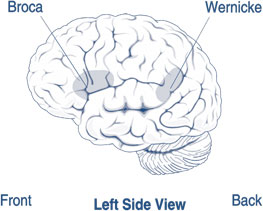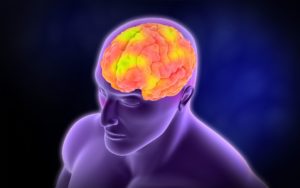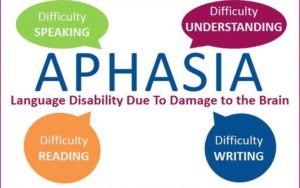What is aphasia?
Aphasia is a disorder that results from damage to portions of the brain that are responsible for language. For most people, these areas are on the left side of the brain. Aphasia usually occurs suddenly, often following a stroke or head injury, but it may also develop slowly, as the result of a brain tumor or a progressive neurological disease. The disorder impairs the expression and understanding of language as well as reading and writing. Aphasia may co-occur with speech disorders, such as dysarthria or apraxia of speech, which also result from brain damage.
Who can acquire aphasia?
Most people who have aphasia are middle-aged or older, but anyone can acquire it, including young children. About 1 million people in the United States currently have aphasia, and nearly 180,000 Americans acquire it each year, according to the National Aphasia Association.
What causes aphasia?
Aphasia is caused by damage to one or more of the language areas of the brain. Most often, the cause of the brain injury is a stroke. A stroke occurs when a blood clot or a leaking or burst vessel cuts off blood flow to part of the brain. Brain cells die when they do not receive their normal supply of blood, which carries oxygen and important nutrients. Other causes of brain injury are severe blows to the head, brain tumors, gunshot wounds, brain infections, and progressive neurological disorders, such as Alzheimer’s disease.
- stroke – the most common cause of aphasia.
- severe head injury.
- a brain tumor.
- progressive neurological conditions – conditions that cause the brain and nervous system to become damaged over time, such as dementia.

Areas of the brain affected by Broca’s and Wernicke’s aphasia
What types of aphasia are there?
There are two broad categories of aphasia: 1-fluent and 2-nonfluent, but know there are several types within these groups. So the 2 main groups of aphasia are as follows:
1- Fluent aphasia
There is damage to the posterior temporal lobe of the brain.
This may result in Wernicke’s aphasia (see figure above), the most common type of fluent aphasia. People with Wernicke’s aphasia may speak in long, complete sentences that have no meaning, adding unnecessary words and even creating made-up words.
For example, someone with Wernicke’s aphasia may say, “You know that smoodle pinkered and that I want to get him round and take care of him like you want before.”
As a result, it is often difficult to follow what the person is trying to say. People with Wernicke’s aphasia are often unaware of their spoken mistakes. Another hallmark of this type of aphasia is difficulty understanding speech.
2- Nonfluent aphasia
The most common type of nonfluent aphasia is Broca’s aphasia (see figure above).
People with Broca’s aphasia have damage that primarily affects the frontal lobe of the brain. Damage to a discrete part of the brain in the left frontal lobe (Broca’s area) of the language-dominant hemisphere has been shown to significantly affect the use of spontaneous speech and motor speech control. Words may be uttered very slowly and poorly articulated.
They often have right-sided weakness or paralysis of the arm and leg because the frontal lobe is also important for motor movements. People with Broca’s aphasia may understand speech and know what they want to say, but they frequently speak in short phrases that are produced with great effort. They often omit small words, such as “is,” “and” and “the.”
For example, a person with Broca’s aphasia may say, “Walk dog,” meaning, “I will take the dog for a walk,” or “book book two table,” for “There are two books on the table.” People with Broca’s aphasia typically understand the speech of others fairly well. Because of this, they are often aware of their difficulties and can become easily frustrated.
OTHER TYPES OF APHASIA:
– Global aphasia, results from damage to extensive portions of the language areas of the brain. Individuals with global aphasia have severe communication difficulties and may be extremely limited in their ability to speak or comprehend language. Damage to the language processing centers in the left hemisphere of your brain, including Wernicke’s and Broca’s areas, can cause global aphasia. These two areas are critical for the production and understanding of language.
This is the most severe form of aphasia. It usually involves the following features.
- Loss of fluency. People with global aphasia struggle with the physical act of speaking. People with the most severe forms of this might only make small or isolated sounds, or they might not make any sounds at all (mutism). They also may repeat words or simple phrases over and over (this is a problem with fluency, as they’ll still have trouble repeating back words or phrases you say to them).
- Problems with understanding. People with this struggle to understand what others are saying. They might understand very simple sentences, but the more complex the sentence or phrase, the harder it is to understand.
- Struggle with repetition. Global aphasia affects repetition, meaning a person with it might struggle to repeat back words or phrases you say to them.
- Other symptoms: This kind of aphasia happens with conditions that cause severe brain damage, such as major strokes or head injuries. The damage is usually severe and affects multiple parts of the brain, causing other serious symptoms like one-sided paralysis, blindness and more.
Other forms of aphasia
- Transcortical motor aphasia: This is similar to Broca’s aphasia but usually not as severe. A key difference is that people with this don’t have a problem repeating back phrases or sentences you say to them.
- Transcortical sensory aphasia: This type is similar to Wernicke’s aphasia but usually not as severe. Like with transcortical motor aphasia above, people with this type don’t have a problem repeating back what you say. This type of aphasia is common with degenerative brain conditions like Alzheimer’s disease.
- Conduction aphasia: This type of aphasia affects fluency but not understanding. People with this struggle to pronounce words, especially when trying to repeat something you say to them.
- Mixed transcortical aphasia: This aphasia is like global aphasia, except that people with this can still repeat what people say to them.
- Anomic aphasia: People with this kind of aphasia struggle to find words, especially names of objects or words that describe actions. To get around this problem, they often use several words to explain what they mean or non-specific words like “thing” instead.

